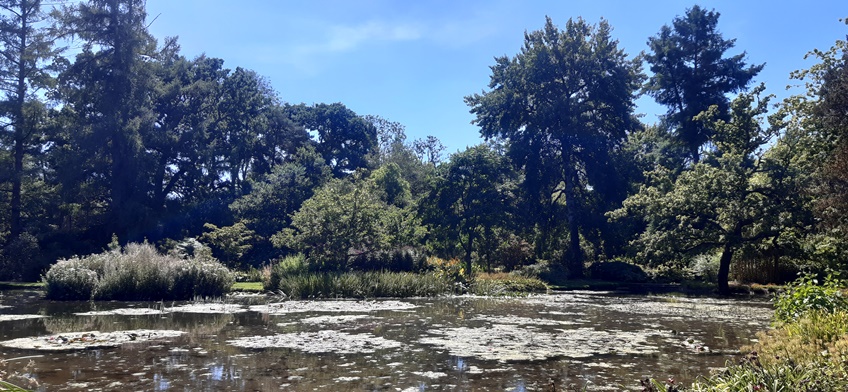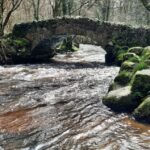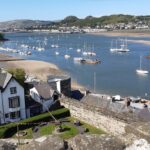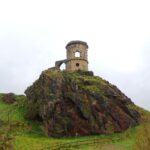Just a stone’s throw away from Hampshire’s meandering River Test, the most famous trout loving chalk stream in the country, a small diversion channels the waters into a green oasis in the sun parched valley.
Here are the outstandingly colourful Longstock Park Watergardens, originally created by the extraction of gravel, which formed a lake and encouraged the Beddington family to create the water gardens back in the 1920s.
The gardens were purchased by John Spedan Lewis, founder of The John Lewis Partnership, as part of his Leckford estate, in 1947 and became his life-long passion.
Today they are the finest water gardens in the world, according to the International Water Lilly Society.
My wife Jenny, a keen gardener, and I were shown around by Head Gardener Rob Ballard. He came from the famous Cliveden Estate in Buckinghamshire, seeking to further broaden his experience, and not intending to stay long, but that was eighteen years ago!
‘I simply fell in love with this tranquil water garden environment, with its high-water table, an antidote to drought, rich variety of plants and habitats and wonderful mirror-like reflections,’ he said.
One dramatic, but often little noticed effect of the high water table, were the deeply crevassed barks on neighbouring trees because of their close access to water, he pointed out.
Rob told how in summertime, he often donned waders and spent hours in water up to his armpits dead heading the water lilies to encourage them to go on flowering as long as possible for the delight of visitors.
Close by is the estate’s spacious green oak framed farm shop, café, extensive plant and tree nursery and walled garden housing the National Buddleia Collection.
We lunched on warm trout quiche and salad before going in search of the butterfly loving buddleias in the hope of finding a host of the tiny colourful insects that seem to have deserted Jenny’s flower and shrub garden back home in Monmouthshire this summer.
But alas, while indeed finding an information notice displaying pictures of more than twenty butterflies likely to be seen, there were few in sight.

I first came across the picturesque market town of Romsey, with its centuries old White Horse Hotel, while walking the River Test Trail, which runs for forty-four miles from high on the rolling North Wessex Downs to Southampton Water and decided to return and explore the area and it gardens.
Choosing to stay in the White Horse in Market Place, we soon discovered its links with the nearby Romsey Abbey, which dates back to the 900s
We were shown around by volunteer Alan Blusher, who has lived in the town for many years, and revealed that the hotel’s Tudor frame, now hidden behind brickwork, dated back to the times when nuns were still in residence over at the abbey.
This magnificent building escaped the ravages of Henry the Eighth’s dissolution of the monasteries because it stood alone in River Test water meadows, some distance from the present town and four, clearly wealth folk paid him the then princely sum of £100 for it.
But the priory at nearby Mottisfont was not so fortunate, as we were to learn later.
While the document of sale, with Henry’s signature upon it is still on display in the church, Florence Nightingale lived nearby and a colourful commemorative window by stained glass artist Sophie Hacker was installed in 2020.

After an excellent alfresco dinner and a comfortable night at The White Horse, we made the short drive to the National Trust’s Mottisfont House and estate, which covers over two thousand acres.
Here in cellars that existed in priory times, we came upon a plaque explaining that King Henry VIII was keen that former priories and monasteries be quickly dismantled and changed irreparably and that new owners had a year to start work or he would take the properties back.
His Lord Chancellor, Sir William Sandys, who was gifted Mottisfont in exchange for the villages of Chelsea and Paddington, simply retained the priory’s nave and built up a house with rooms within it and demolished everything around it.
Fascinating glimpses of the original nave can still be found within the building, which is open to the public, but we had an extra treat instore thanks to the heatwave because outside on the sun parched lawn, the outlines of the long-demolished cloisters were now clearly visible.
In more recent times the affluent Russell family bought the then dilapidated house and under the guidance of Maud Russell it was restored to create a luxurious neo-classical setting for their weekend house parties.
The family made Mottisfont the centre of a 1930s fashionable artistic and political circle where bright young things rubbed shoulders with politicians, writers and painters.

The house was requisitioned during World War Two to become a convalescent home for wounded officers and Maud went to work for the admiralty, returning home at weekends.
After the war, she made Mottisfont her main home and lived on there for thirty years before handing the property over to the National Trust in 1957.
Like the Longstock Park Water gardens, previous owners of Mottisfont, took advantage of the nearby River Test to divert and create a delightful riverside walk below the house, now shaded by trees, which is a “must” for visitors.
We stopped several times to gaze down through the shallow crystal-clear waters to spot the brown trout lazing in the shadows.
A magnificent London Plane Tree, said to be the largest in Britain, appears to rise and dominate the house when viewed from some perspectives, and forms part of the national collection to be found offering welcome shade around the grounds.
Fact file
Readers wishing to follow in Nigel and Jenny’s footsteps, while staying at The White Horse Hotel in Romsey should call 01794 337 810.
For details of the the water gardens follow this link.
For Mottisfont House and gardens visit The National Trust website.
His Walking the Test Trail travel article can also be located on the Mature Times website for those seeking further background on visiting this delightfully unspoilt area by following this link.
Many more of his UK and world-wide travel articles can be found in A Wander Through My Life by Nigel Heath which is available on Amazon Kindle Books.




